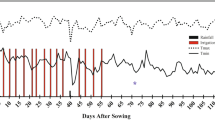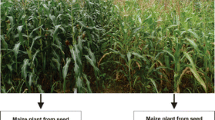Abstract
Aims
We evaluated the effect of Azospirillum brasilense strain HM053 inoculation on maize seeds, a spontaneous mutant that excrete ammonium and fix nitrogen constitutively.
Methods
Maize was grown with different nitrogen (urea) concentration and inoculated with A. brasilense Ab-V5 (Brazilian commercial strain) or HM053 strain in four field experiments, in three regions of Parana State, Southern Brazil. We evaluated yield components, nutrient content on leaves and grains and productivity during the crop cycle.
Results
Inoculation with A. brasilense strain Ab-V5 and HM053 associated with base fertilization (30 kg ha−1 N) improved crop yield in all trials. Ab-V5 increased production between 2.2 to 10.4%, or 178.0 to 759.9 kg ha−1, respectively. HM053, by itself, increased production between 4.7 to 29%, or 460.5 to 1769.3 kg ha−1, respectively.
Conclusion
The new strain HM053 showed to be a great biofertilizer for maize seeds and a new alternative for a more sustainable agriculture.

Similar content being viewed by others
References
AOAC (1998) official method 992.15, combustion method, 16 th Edition
Aquino GS, Ventura MU, Alexandrino RP, Michelon TA, Araujo Pescador PG, Nicio TT, Watanabe VS, Diniz TG, Oliveira ALM, Hata FT (2018) Plant-promoting rhizobacteria Methylobacterium komagatae increases crambe yields, root system and plant height. Ind Crop Prod 121:277–281. https://doi.org/10.1016/j.indcrop.2018.05.020
Araújo LM, Monteiro RA, Souza EM, Steffens MBR, Rigo LU, Pedrosa FO, Chubatsu LS (2004) GlnB is specifically required for Azospirillum brasilense NifA activity in Escherichia coli. Res Microbiol 155:491–495. https://doi.org/10.1016/j.resmic.2004.03.002
Arcondéguy T, Jack R, Merrick M (2001) PII signal transduction proteins, pivotal players in microbial nitrogen control. Microbiol Mol Biol Rev 65:80–105. https://doi.org/10.1128/MMBR.65.1.80-105.2001
Arsene F, Kaminski PA, Elmerich C (1996) Modulation of NifA activity by PII in Azospirillum brasilense: evidence for a regulatory role of the NifA N-terminal domain. J Bacteriol 178:4830–4838
Arzanesh MH, Alikhani HA, Khavazi K, Rahimian HA, Miransari M (2011) Wheat (Triticum aestivum L.) growth enhancement by Azospirillum sp. under drought stress. World J Microbiol Biotechnol 27(2):197–205. https://doi.org/10.1007/s11274-010-0444-1
Baldani JI, Baldani VL (2005) History on the biological nitrogen fixation research in graminaceous plants: special emphasis on the Brazilian experience. An. Acad. Bras. Ciênc. An Acad Bras Cienc 77(3):549–579. https://doi.org/10.1590/S0001-37652005000300014
Bashan Y, de-Bashan L (2010) How the plant growth-promoting bacterium Azospirillum promotes plant growth. A critical assessment. Adv Agron 108:77–136. https://doi.org/10.1016/S0065-2113(10)08002-8
Bashan Y, Levanony H (1990) Current status of Azospirillum inoculation technology: Azospirillum as a challenge for agriculture. Can J Microbiol 36(9):591–608. https://doi.org/10.1139/m90-105
Bashan Y, Holguin G, de-Bashan LE (2004) Azospirillum-plant relationships: physiological, molecular, agricultural, and environmental advances (1997-2003). Can J Microbiol 50:521–577. https://doi.org/10.1139/w04-035
Calvo P, Nelson L, Kloepper JW (2014) Agricultural uses of plant biostimulants. Plant Soil 383:3–41. https://doi.org/10.1007/s11104-014-2131-8
Calzavara AK, Paiva PHG, Gabriel LC, Oliveira ALM, Milani K, Oliveira HC, Bianchini E, Pimenta JA, Oliveira MCN, Dias-Pereira J, Stolf-Moreira R (2018) Associative bacteria influence maize (Zea mays L.) growth, physiology and root anatomy under different nitrogen levels. Plant Biol 20(5):870–878. https://doi.org/10.1111/plb.12841
Cassán F, Diaz-Zorita M (2016) Azospirillum sp. in current agriculture: from the laboratory to the field. Soil Biol Biochem 103:117–130. https://doi.org/10.1016/j.soilbio.2016.08.020
Cassán F, Vanderleyden J, Spaepen S (2014) Physiological and agronomical aspects of phytohormone production by model plant growth promoting rhizobacteria (PGPR) belonging to the genus Azospirillum. J Plant Growth Regul 33:440–459. https://doi.org/10.1007/s00344-013-9362-4
Creus C, Sueldo R, Barassi C (1997) Shoot growth and water status in Azospirillum inoculated wheat seedlings grown under osmotic and salt stresses. Plant Physiol Biochem 35:939–944
Díaz-Zorita M, Fernández-Canigia MV, Bravo OA, Berger A, Satorre EH (2015) Field evaluation of extensive crops inoculated with Azospirillum sp. In: Cassán FD, Okon Y, Creus CM (eds) Handbook for Azospirillum, technical issues and protocols. Springer Int. Publishing, Cham, pp 435–445. https://doi.org/10.1007/978-3-319-06542-7_24
Dimkpa C, Weinand T, Asch F (2009) Plant–rhizobacteria interactions alleviate abiotic stress conditions. Plant Cell Environ 32(12):1682–1694. https://doi.org/10.1111/j.1365-3040.2009.02028.x
Dobbelaere S, Croonenborghs A, Thys A, Ptacek D, Vanderleyden J, Dutto P, Labandera-Gonzalez C, Caballero-Mellado J, Aguirr JF, Kapulnik Y, Brener S, Burdman S, Kadouri D, Sarig S, Pkon Y (2001) Responses of agronomically important crops to inoculation with Azospirillum. Aust J Plant Physiol 28:871–879. https://doi.org/10.1071/PP01074
Döbereiner J, Day JM (1976) Associative symbiosis in tropical grasses: characterization of microorganisms and dinitrogen-fixing sites. In: Newton WE, Nyman CT (eds) Proceedings of the international symposium on nitrogen fixation, vol 2. Washington State University Press, Pullman, pp 518–538
Döbereiner J, Pedrosa FO (1987) Nitrogen-fixing bacteria in nonleguminous crop plants. Science tech. Springer Verlag, Madison, pp 1–155
Elmerich C, Aubert JP (1971) Synthesis of glutamate by a glutamine: 2-oxo-glutarate amidotransferase (NADP oxidoreductase) in Bacillus megaterium. Biochem Biophys Res Commun 42:371–376
Embrapa - Empresa Brasileira de Pesquisa Agropecuária (1999) Manual de análises químicas de solos, plantas e fertilizantes. Embrapa, Brasilia, pp 175–180
Fadel-Picheth CMT, Souza EM, Rigo LU, Funayama S (1999) Regulation of Azospirillum brasilense nifA gene expression by ammonium and oxygen. FEMS Microbiol Lett 179:281–288
Fu H, Hartmann A, Lowery RG, Fitzmaurice WP, Roberts GP, Burris RH (1989) Posttranslational regulatory system for nitrogenase activity in Azospirillum spp. J Bacteriol 171:4679–4685
Huergo LF, Pedrosa FO, Muller-Santos M, Chubatsu LS, Monteiro RA, Merrick M, Souza EM (2012) PII signal transduction proteins: pivotal players in post-translational control of nitrogenase activity. Microbiology 158:176–190. https://doi.org/10.1099/mic.0.049783-0
Hungria M, Campo RJ, Souza EM, Pedrosa FO (2010) Inoculation with selected strains of Azospirillum brasilense and A. lipoferum improves yields of maize and wheat in Brazil. Plant Soil 331:413–425. https://doi.org/10.1007/s11104-009-0262-0
Machado HB, Funayama S, Rigo LU, Pedrosa FO (1991) Excretion of ammonium by Azospirillum brasilense mutants resistant to ethylenediamine. Can J Microbiol 37:549–553
Magalhães PC, Durães FOM (2006) Fisiologia da Produção de Milho. Embrapa. Sete Lagoas, p10. ISSN 1679-1150
Martins RM, Jantalia CP, Reis VM, Döwich I, Polidoro JC, Alves BJR, Boddey RM, Urquiaga S (2018) Impact of plant growth-promoting bacteria on grain yield, protein content, and urea-15 N recovery by maize in a Cerrado Oxisol. Plant Soil 422:239–250. https://doi.org/10.1007/s11104-017-3193-1
Meers J, Tempest D (1970) “Glutamine(amide): 2-oxoglutarate amino transferase oxido-reductase (NADP)”, an enzyme involved in the synthesis of glutamate by some bacteria. J Gen Microbiol 64:187–194
Moure VR, Danyal K, Yang Z-Y, Wendroth S, Müller-Santos M, Pedrosa FO, Scarduelli M, Gerhardt EC, Huergo LF, Souza EM, Seefeldt LC (2013) The nitrogenase regulatory enzyme dinitrogenase reductase ADP ribosyltransferase (DraT) is activated by direct interaction with the signal transduction protein GlnB. J Bacteriol 195:279–286. https://doi.org/10.1128/JB.01517-12
Okon Y, Heytler P, Hardy W (1983) N2 fixation by Azospirillum brasilense and its incorporation into host Setaria italica. Appl Environ Microbiol 46:694–697
Oliveira AL, Santos OJ, Marcelino PR, Milani KM, Zuluaga MY, Zucareli C, Gonçalves LS (2017) Maize inoculation with Azospirillum brasilense ab-V5 cells enriched with exopolysaccharides and polyhydroxybutyrate results in high productivity under low N fertilizer input. Front Microbiol 8:1873. https://doi.org/10.3389/fmicb.2017.01873
Pankievicz VCS, Amaral FP, Santos KFDN, Agtuca B, Xu Y, Schueller MJ, Arisi ACM, Steffens MBR, Souza EM, Pedrosa FO, Stacey G, Ferrieri RA (2015) Robust biological nitrogen fixation in a model grass-bacterial association. Plant J 81:907–919. https://doi.org/10.1111/tpj.12777
Pauletti V, Motta ACV (2017) Manual de adubação e calagem para o estado do Paraná. Curitiba: Sociedade Brasileira de Ciência do Solo, Núcleo Estadual Paraná. ISBN 978–85–69146-04-9
Pavan MA, Bloch MF, Zempulski HD, Miyazawa M, Zocoler DC (1992) Manual de análise química do solo e controle de qualidade. Instituto Agronômico do Paraná, Londrina, Brazil, 40 pp ISSN: 0100–3356
Puente M, Li C, Bashan Y (2004) Microbial populations and activities in the rhizoplane of rock-weathering desert plants. II. Growth promotion of cactos seedlings. Plant Biol 6:643–650. https://doi.org/10.1055/s-2004-821101
R Core Team (2018) R: a Language and Environment for Statistical Computing. R Foundation for Statistical Computing, Vienna, Austria. https://www.R-project.org/
Rodrigues, RC (2010) Métodos de análises bromatológicas de alimentos: métodos físicos, químicos e bromatológicos. Embrapa, Pelotas. ISSN 1806-9193
Santos ARS, Etto RM, Furmam RW, de Freitas DL, Santos KFDEN, Souza EM, Pedrosa FO, Ayub RA, Steffens MBR, Galvão CW (2017a) Labeled Azospirillum brasilense wild type and excretion-ammonium strains in association with barley roots. Plant Physiol Biochem 118:422–426. https://doi.org/10.1016/j.plaphy.2017.07.003
Santos KFDN, Moure VR, Hauer V, Santos ARS, Donatti L, Galvão CW, Pedrosa FO, Souza EM, Wassem R, Steffens MBR (2017b) Wheat colonization by an Azospirillum brasilense ammonium-excreting strain reveals upregulation of nitrogenase and superior plant growth promotion. Plant Soil 415:245–255. https://doi.org/10.1007/s11104-016-3140-6
Singh DP, Singh HB, Prabha R (2016) Microbial inoculants in sustainable agricultural productivity. Springer, New York ISBN: 978-8132226420
Tarrand JJ, Krieg NR, Döbereiner J (1978) A taxonomic study of the Spirillum lipoferum group, with descriptions of a new genus, Azospirillum gen. Nov. and two species, Azospirillum lipoferum (Beijerinck) comb. nov. and Azospirillum brasilense sp. nov. Can J Microbiol 24:967–980
Tiepo AN, Hertel MF, Rocha SS, Calzavara AK, Oliveira ALM, Pimenta JA, Oliveira HC, Bianchini E, Stolf-Moreira R (2018) Enhanced drought tolerance in seedlings of Neotropical tree species inoculated with plant growth-promoting bacteria. Plant Physiol Biochem 130:277–288. https://doi.org/10.1016/j.plaphy.2018.07.021
Timmusk S, Behers L, Muthon J, Muraya A, Aronsson AC (2017) Perspectives and challenges of microbial application for crop improvement. Front Plant Sci 8:49. https://doi.org/10.3389/fpls.2017.00049
Acknowledgements
We thank the Brazilian Program of National Institutes of Science and Technology-INCT/Brazilian Research Council-CNPq/MCT, CNPq, CAPES and Fundação Araucária for the financial support.
Author information
Authors and Affiliations
Corresponding author
Additional information
Responsible Editor: Anton Hartmann.
Publisher’s note
Springer Nature remains neutral with regard to jurisdictional claims in published maps and institutional affiliations.
Electronic supplementary material
ESM 1
(DOCX 280 kb)
Rights and permissions
About this article
Cite this article
Pedrosa, F.O., Oliveira, A.L.M., Guimarães, V.F. et al. The ammonium excreting Azospirillum brasilense strain HM053: a new alternative inoculant for maize. Plant Soil 451, 45–56 (2020). https://doi.org/10.1007/s11104-019-04124-8
Received:
Accepted:
Published:
Issue Date:
DOI: https://doi.org/10.1007/s11104-019-04124-8




